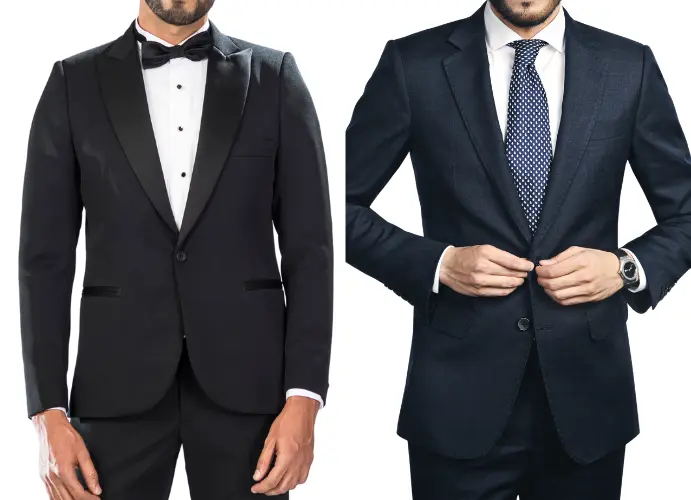Navigating the world of formal attire can be a daunting task, especially when it comes to distinguishing between a tuxedo and a suit. While both are staples in men’s formalwear, understanding their differences is crucial for making the right fashion choice for any formal event. This blog post delves into the key distinctions between these two iconic styles, ensuring you’re impeccably dressed for your next big occasion.
The Distinctive Features of a Tuxedo

Introduction to Tuxedo Characteristics
Known by most as a “tux,” a tuxedo is distinguished from other formal attire by its distinct characteristics and the degree of refinement it lends to special events.
Satin Accents
The most notable characteristic of a tuxedo is the presence of satin. Satin is typically found on the lapels, buttons, pocket trim, and a stripe down the leg of the trousers. This touch of sheen contrasts with the matte fabric of the rest of the garment, giving the tuxedo its distinctive, elegant appearance.
The Formal Shirt and Accessories
A tuxedo, often a key element in men’s formal wear, is traditionally paired with a white dress shirt featuring a wingtip or turndown collar. Accessories such as a bow tie, cummerbund, or waistcoat are essential to complete the classic look of men’s tuxedos. These elements work in harmony to elevate the outfit, making it ideal for the most formal events like black-tie galas or weddings, where the sophistication and elegance of a tuxedo truly shine.
The Versatility of a Suit

Introduction to Suit Characteristics
Suits are versatile pieces in menswear, suitable for a variety of settings from business meetings to semi-formal events. Understanding what sets a suit apart is key to choosing the right outfit for less formal occasions.
Fabric and Design
Fabric and design are pivotal elements in distinguishing between a tuxedo and a suit. A tuxedo traditionally features satin accents on lapels, buttons, and a side stripe on trousers, creating a distinct contrast with its matte fabric body. This adds an air of elegance and formality, making the tuxedo a staple for high-end events. In contrast, suits are characterized by their uniform fabric throughout, with lapels made from the same material as the suit itself. This lack of satin detailing offers a more understated, versatile appearance. Suits come in a variety of fabrics, colors, and patterns, allowing for greater personal expression and adaptability across different occasions, from business meetings to casual gatherings, showcasing their functionality and style diversity.
Suit Pairings and Flexibility
A suit is typically paired with a collared dress shirt and a necktie or bow tie. The lack of strict accessory rules compared to a tuxedo allows for greater flexibility in personal style and occasion appropriateness. From business attire to semi-formal events, suits can be dressed up or down according to the occasion.
Conclusion

In conclusion, understanding the key differences between a tuxedo and a suit is essential for making the right choice in formalwear. They are the go-to for high-level formal events with their distinctive satin accents and specific accessory requirements. On the other hand, suits offer greater versatility and personalization for a range of less formal occasions. With this knowledge, you can confidently select the appropriate attire and make a lasting impression at your next event.

